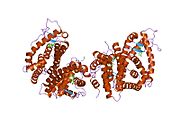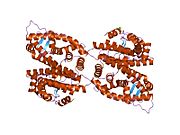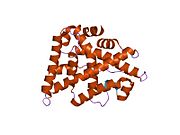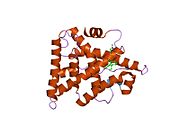Biology:Estrogen-related receptor gamma
 Generic protein structure example |
Estrogen-related receptor gamma (ERR-gamma), also known as NR3B3 (nuclear receptor subfamily 3, group B, member 3), is a nuclear receptor that in humans is encoded by the ESRRG (EStrogen Related Receptor Gamma) gene.[1][2][3] It behaves as a constitutive activator of transcription.[4]
This protein is a member of nuclear hormone receptor family of steroid hormone receptors. No physiological activating ligand is known for this orphan receptor, but 4-hydroxytamoxifen and diethylstilbestrol act as inverse agonists and deactivate ESRRG.[5] It also seems to be the target of bisphenol A (see below).
Bisphenol A binding
There is evidence that bisphenol A functions as a xenoestrogen by binding strongly to ERR-γ.[4] BPA as well as its nitrated and chlorinated metabolites seems to binds strongly to ERR-γ (dissociation constant = 5.5 nM), but not to the estrogen receptor (ER).,[4][6] BPA binding to ERR-γ preserves its basal constitutive activity.[4] It can also protect it from deactivation from the selective estrogen receptor modulator 4-hydroxytamoxifen.[4]
Different expression of ERR-γ in different parts of the body may account for variations in bisphenol A effects. For instance, ERR-γ has been found in high concentration in the placenta, explaining reports of high bisphenol A accumulation there.[7]
References
- ↑ "Entrez Gene: ESRRG estrogen-related receptor gamma". https://www.ncbi.nlm.nih.gov/sites/entrez?Db=gene&Cmd=ShowDetailView&TermToSearch=2104.
- ↑ "Isolation of a gene encoding a novel member of the nuclear receptor superfamily from the critical region of Usher syndrome type IIa at 1q41". Genomics 50 (3): 382–4. Jun 1998. doi:10.1006/geno.1998.5345. PMID 9676434.
- ↑ "Identification of two hERR2-related novel nuclear receptors utilizing bioinformatics and inverse PCR". Gene 228 (1–2): 101–9. Mar 1999. doi:10.1016/S0378-1119(98)00619-2. PMID 10072763.
- ↑ 4.0 4.1 4.2 4.3 4.4 "Structural evidence for endocrine disruptor bisphenol A binding to human nuclear receptor ERR gamma". Journal of Biochemistry 142 (4): 517–24. Oct 2007. doi:10.1093/jb/mvm158. PMID 17761695.
- ↑ "Dimerization modulates the activity of the orphan nuclear receptor ERRgamma". Biochemical and Biophysical Research Communications 314 (4): 964–70. Feb 2004. doi:10.1016/j.bbrc.2003.12.194. PMID 14751226.
- ↑ "Molecular docking of bisphenol A and its nitrated and chlorinated metabolites onto human estrogen-related receptor-gamma". Biochemical and Biophysical Research Communications 426 (2): 215–20. Sep 2012. doi:10.1016/j.bbrc.2012.08.065. PMID 22935422.
- ↑ "Placenta expressing the greatest quantity of bisphenol A receptor ERR{gamma} among the human reproductive tissues: Predominant expression of type-1 ERRgamma isoform". Journal of Biochemistry 146 (1): 113–22. Jul 2009. doi:10.1093/jb/mvp049. PMID 19304792.
Further reading
- "Normalization and subtraction: two approaches to facilitate gene discovery". Genome Research 6 (9): 791–806. Sep 1996. doi:10.1101/gr.6.9.791. PMID 8889548.
- "Prediction of the coding sequences of unidentified human genes. XII. The complete sequences of 100 new cDNA clones from brain which code for large proteins in vitro". DNA Research 5 (6): 355–64. Dec 1998. doi:10.1093/dnares/5.6.355. PMID 10048485.
- "Hormone-independent transcriptional activation and coactivator binding by novel orphan nuclear receptor ERR3". The Journal of Biological Chemistry 274 (32): 22618–26. Aug 1999. doi:10.1074/jbc.274.32.22618. PMID 10428842.
- "Human ERRgamma, a third member of the estrogen receptor-related receptor (ERR) subfamily of orphan nuclear receptors: tissue-specific isoforms are expressed during development and in the adult". Molecular Endocrinology 14 (3): 382–92. Mar 2000. doi:10.1210/mend.14.3.0431. PMID 10707956.
- "Structural and functional evidence for ligand-independent transcriptional activation by the estrogen-related receptor 3". Molecular Cell 9 (2): 303–13. Feb 2002. doi:10.1016/S1097-2765(02)00444-6. PMID 11864604.
- "Expressed sequence tag analysis of human RPE/choroid for the NEIBank Project: over 6000 non-redundant transcripts, novel genes and splice variants". Molecular Vision 8: 205–20. Jun 2002. PMID 12107410.
- "Domains of ERRgamma that mediate homodimerization and interaction with factors stimulating DNA binding". European Journal of Biochemistry 269 (16): 4086–97. Aug 2002. doi:10.1046/j.1432-1033.2002.03102.x. PMID 12180985.
- "PGC-1 and PERC, coactivators of the estrogen receptor-related receptor gamma". Biochemical and Biophysical Research Communications 299 (5): 872–9. Dec 2002. doi:10.1016/S0006-291X(02)02753-5. PMID 12470660.
- "Characterization of calmodulin binding to the orphan nuclear receptor Errgamma". Biological Chemistry 384 (3): 473–82. Mar 2003. doi:10.1515/BC.2003.053. PMID 12715898.
- "Identification of PNRC2 and TLE1 as activation function-1 cofactors of the orphan nuclear receptor ERRgamma". Biochemical and Biophysical Research Communications 312 (4): 975–82. Dec 2003. doi:10.1016/j.bbrc.2003.11.025. PMID 14651967.
- "Expression and functional study of estrogen receptor-related receptors in human prostatic cells and tissues". The Journal of Clinical Endocrinology and Metabolism 90 (3): 1830–44. Mar 2005. doi:10.1210/jc.2004-1421. PMID 15598686.
- "Estrogen-related receptor-gamma and peroxisome proliferator-activated receptor-gamma coactivator-1alpha regulate estrogen-related receptor-alpha gene expression via a conserved multi-hormone response element". Journal of Molecular Endocrinology 34 (2): 473–87. Apr 2005. doi:10.1677/jme.1.01586. PMID 15821111.
- "Expression of estrogen receptor-related receptor isoforms and clinical significance in endometrial adenocarcinoma". International Journal of Gynecological Cancer 16 (2): 827–33. 2006. doi:10.1111/j.1525-1438.2006.00527.x. PMID 16681769.
- "X-ray crystal structures of the estrogen-related receptor-gamma ligand binding domain in three functional states reveal the molecular basis of small molecule regulation". The Journal of Biological Chemistry 281 (49): 37773–81. Dec 2006. doi:10.1074/jbc.M608410200. PMID 16990259.
- "Molecular docking of bisphenol A and its nitrated and chlorinated metabolites onto human estrogen-related receptor-gamma". Biochemical and Biophysical Research Communications 426 (2): 215–20. Sep 2012. doi:10.1016/j.bbrc.2012.08.065. PMID 22935422.
 |













